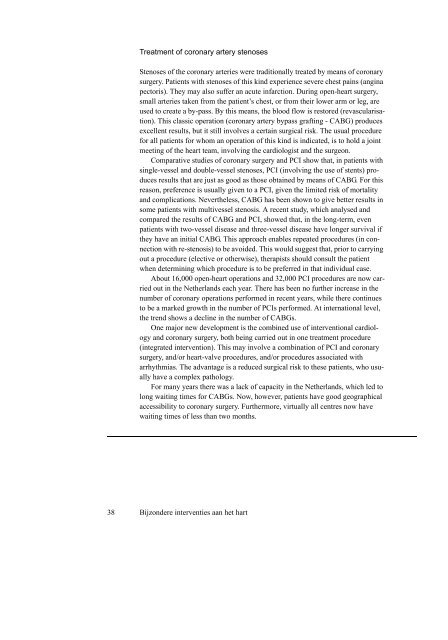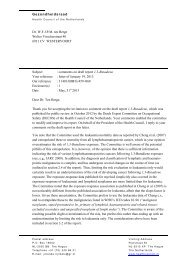Bijzondere interventies aan het hart - Gezondheidsraad
Bijzondere interventies aan het hart - Gezondheidsraad
Bijzondere interventies aan het hart - Gezondheidsraad
Create successful ePaper yourself
Turn your PDF publications into a flip-book with our unique Google optimized e-Paper software.
Treatment of coronary artery stenoses<br />
Stenoses of the coronary arteries were traditionally treated by means of coronary<br />
surgery. Patients with stenoses of this kind experience severe chest pains (angina<br />
pectoris). They may also suffer an acute infarction. During open-heart surgery,<br />
small arteries taken from the patient’s chest, or from their lower arm or leg, are<br />
used to create a by-pass. By this means, the blood flow is restored (revascularisation).<br />
This classic operation (coronary artery bypass grafting - CABG) produces<br />
excellent results, but it still involves a certain surgical risk. The usual procedure<br />
for all patients for whom an operation of this kind is indicated, is to hold a joint<br />
meeting of the heart team, involving the cardiologist and the surgeon.<br />
Comparative studies of coronary surgery and PCI show that, in patients with<br />
single-vessel and double-vessel stenoses, PCI (involving the use of stents) produces<br />
results that are just as good as those obtained by means of CABG. For this<br />
reason, preference is usually given to a PCI, given the limited risk of mortality<br />
and complications. Nevertheless, CABG has been shown to give better results in<br />
some patients with multivessel stenosis. A recent study, which analysed and<br />
compared the results of CABG and PCI, showed that, in the long-term, even<br />
patients with two-vessel disease and three-vessel disease have longer survival if<br />
they have an initial CABG. This approach enables repeated procedures (in connection<br />
with re-stenosis) to be avoided. This would suggest that, prior to carrying<br />
out a procedure (elective or otherwise), therapists should consult the patient<br />
when determining which procedure is to be preferred in that individual case.<br />
About 16,000 open-heart operations and 32,000 PCI procedures are now carried<br />
out in the Netherlands each year. There has been no further increase in the<br />
number of coronary operations performed in recent years, while there continues<br />
to be a marked growth in the number of PCIs performed. At international level,<br />
the trend shows a decline in the number of CABGs.<br />
One major new development is the combined use of interventional cardiology<br />
and coronary surgery, both being carried out in one treatment procedure<br />
(integrated intervention). This may involve a combination of PCI and coronary<br />
surgery, and/or heart-valve procedures, and/or procedures associated with<br />
arrhythmias. The advantage is a reduced surgical risk to these patients, who usually<br />
have a complex pathology.<br />
For many years there was a lack of capacity in the Netherlands, which led to<br />
long waiting times for CABGs. Now, however, patients have good geographical<br />
accessibility to coronary surgery. Furthermore, virtually all centres now have<br />
waiting times of less than two months.<br />
38 <strong>Bijzondere</strong> <strong>interventies</strong> <strong>aan</strong> <strong>het</strong> <strong>hart</strong>
















